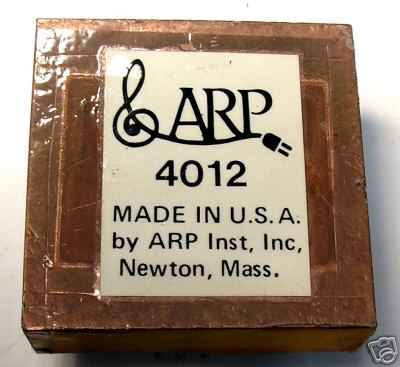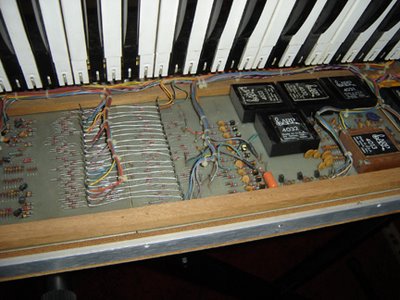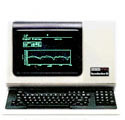
This one in via First Last.
http://members.tripod.com/werdav/vocpzino.htm
Peter Zinovieff was the founder of
EMS.
"Electronic Music Studios Ltd (EMS) London, England. Beginning in a backyard bomb shelter, Peter Zinovieff has created the EMS Company devoted solely to the production of electronic music instruments." Quote pulled from
this page.
Some excerpts from
the diary:
"Today is another grey day ... I wish I was in Raasay. There was a storm last night and the studio roof started to leak. It has leaked every year since it was built and every year it is repaired. Water is dripping onto the computer section. Part of the ceiling looks as if it is going to collapse."
"What an idiosyncratic place they must have found EMS. Chickens in the garden. Computers in the basement. Children rushing around the kitchen. I wisk Sofka to school on the Honda. I meet Robin half way down Putney Hill. 400 yards zoom. "
"We discuss, rather drunkenly, the future of synthesizers and how organs are becoming more like synthesizers and synthesizers more like organs I explain that I have decided that EMS should not try and compete in this market but that we should continue to stick to educational and sophisticated machines."
"I tell Ludwig about the terrible week that has just passed and the exciting constructive week that lies ahead. Ludwig tells me of the bad financial state we are in and how the studio is too expensive for EMS to support and how I'm too extravagant. I can tell he is tired. I suggest that we discuss it at the EMS meeting tomorrow. Already then the meeting is diluted from microprocessors and Bessel functions into one of financial fussing. Another decision.
Later Ludwig quietens down. Nothing better than tea and cake, wine and a peat fire. We really get on very well. It must be a nightmare running EMS' financial affairs. We get to bed at about 1. I am glad Ludwig is back."
"We discuss the Glasgow Hospital project. This is an application that has been submitted to the Wolfson Foundation for a large amount of money to be spent on the computer interrogation of patients and the computer diagnosis of their illnesses. Apparently the right 12 questions could diagnose any known disease. The idea is that the patients will be asked questions in regional accents by the computer. They would then respond by pressing a set of simple keys. Yes, no, sometimes etc. EMS will provide all the hardware and the hospital would provide the doctors. It would be very interesting if it works. Alan will be in charge of the project."
"I must stop the EMS people drinking too much at these lunches. Peter Eastty will be slurred and cantakerous this afternoon if he has any more.
All the EMS team are very high powered. Even though some - like David Cockerell, Richard Monkhouse and Alan Sutcliffe are friends and consultants, they still play an enormously important role in the company. We are extremely lucky. "
"Two pop stars arrive with a roadie at 7. They meet everyone going off from the meeting to play pool at the pub. David and Tim are experts at billiards. In Raasay we found an old bagatelle set. I hope it pulls them back there. David walked in snow for the first time in his life at the new year in Raasay.
It soon turns out that the roadie is the greatest pop-star. He's from Tangerine Dream. One of the others wears a long furry earring. Call me Indie Robin recognises him from Chicago. He says he's travelling incognito. It's a good earring he wears for that.
German pop-stars always seem more workmanlike than Americans. English ones fall into one or other camp but usually are dressed up. The Germans wear scruffy jeans and shave. They have come to look at the Vocoder. We also show them the latest modules that Tim is making.
Robin soon takes them off for who knows what with some friends. Rose, Leo and I go to a newly-opened Russian restaurant in Putney. I become maudlin for the gypsies and the islands of Petersboorg that I never knew."
"I had a terrible dream last night about my neck being cut away leaving my head stuck rigid on my body. I woke rather sick. It must have been too much wine at dinner. Suddenly I realise that it is pouring with rain and that I had removed the polythene sheeting from the roof for Hans' lunch the day before yesterday. That is why I had nightmares and why I feel sick.
My worst fears are justified. Water is once again pouring into the studio. Two panels have fallen off the ceiling Onto the computer racks."
"We open a bottle of Champagne. Ludwig thinks I am extravagant. After lunch Richard comes with the video camera interface. It works as soon as he plugs in the board. My programs have been adapted and we are able to test it straight away.
With this invention I am able to derive patterns from a video image. At the sirnplest these images might be a waveform drawn on a piece of graph paper but at a more complex level I think I will be able to derive very useful musical patterns from more random video images. For instance say I point the camera at a flower and say I apportion density of image to harmonic content and I scan from left to right across the stern of the flower. Then imagine that these sounds are pretty mediocre. Dull. Say then that I turn the camera slightly to the left or choose another flower. Will the sounds be more or less interesting? They certainly won't be the same. What images will give the best sounds. In a way it is getting a video picture to provide a pattern for improvisation.
We try it out. I point the camera into the garden. I run VOCAB and I assign the Video parameters to control DOB.
Suddenly the most marvellously rich, varied and amazing sounds come pouring out of the speakers. They ripple and change. They are the first alssolutely fantastic sounds that the oscillator bank has made. Everyone is moved. At first no-one believes that they are not pr~omposed but as I turn the camera the sounds change. They are convinced. In some ways we are frightened. It's like in the story of tuning in to the death cries of roses as they are cut.
We call over Ludwig. He rings up Germany. I ring David in Paris we hold the telephone to the loudspeakers but there is probably little chance that they can hear what is going on. The children come down. I dare not alter anything. Perhaps the program has got into a random loop. I save it and restart it. Wherever I point the camera there is another set of sounds. Each more rich and varied than the last.
I must keep this a secret. I shall give it to Harry for Orpheus. We must not allow these marvellous things to be heard for a year or two. Apollo's gift to Orpheus was music. I wonder where these sounds come from. Perhaps it's not fluke that we have been working on Orpheus for 3 years. This is our reward.
What a day ! Perhaps all days will now be magical again!
I shall use the last seven days of this journal for my Glasgow Musica Nova talk.
Peter Zinovieff
Summer 1976
source: Bulletin of the Computer Arts Society May 1977 "


 That's right. Apparently you can create sound with sand dunes. Title link takes you to some video samples so you can see and hear it for yourself. Below is the abstract from this white paper. I guess if you can "play" water, why not sand. Another one of Earth's synthesizers.
That's right. Apparently you can create sound with sand dunes. Title link takes you to some video samples so you can see and hear it for yourself. Below is the abstract from this white paper. I guess if you can "play" water, why not sand. Another one of Earth's synthesizers.
 Another shot of an ARP filter pulled from this auction. Funny. I never realized they looked like this. Learn something new every day... Check out the seller's other items as well.
Another shot of an ARP filter pulled from this auction. Funny. I never realized they looked like this. Learn something new every day... Check out the seller's other items as well.
 flickr by shistec ra. Trips me out that the ARP filter modules came in little boxes like that. Title link takes you to more.
flickr by shistec ra. Trips me out that the ARP filter modules came in little boxes like that. Title link takes you to more. I missed putting a post up on this when I first saw it as I thought it was just a site to make ringtones. Turns out you can do that and a lot more.
I missed putting a post up on this when I first saw it as I thought it was just a site to make ringtones. Turns out you can do that and a lot more. 
 "SynclavierX is an OS X application to control actual Synclavier voice cards and memory without the need of the obsolete original computer." Title link takes you to more on DVDBorn, including links to resources, PostPro, Sound Design, and Reference manuals.
"SynclavierX is an OS X application to control actual Synclavier voice cards and memory without the need of the obsolete original computer." Title link takes you to more on DVDBorn, including links to resources, PostPro, Sound Design, and Reference manuals.
 Sequencer by Anyware Instruments, maker of the SEMtex. Title link takes you to more on sequencer.de.
Sequencer by Anyware Instruments, maker of the SEMtex. Title link takes you to more on sequencer.de.












